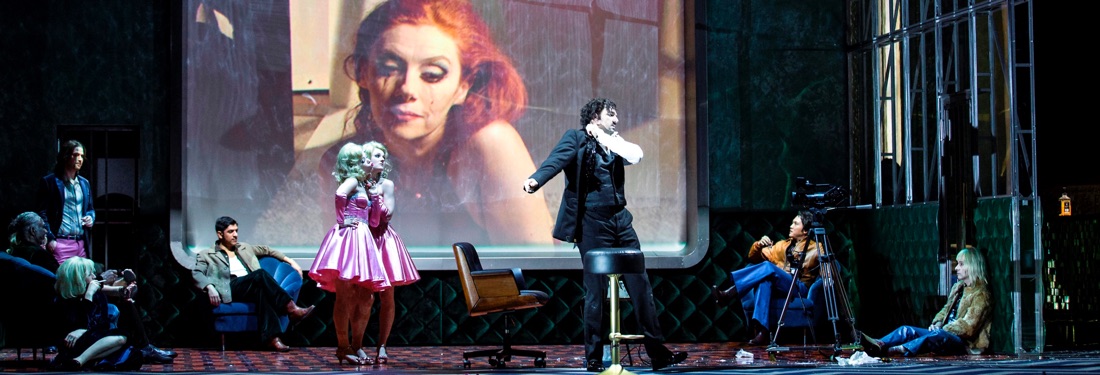

It is always rewarding to hear a young singer make a successful debut, and last night Italian soprano Rosa Feola stunned the usually staid Lyric audience with her brilliant performance as Gilda. It was a near-perfect assumption of the role, with her meltingly beautiful voice, her charismatic stage presence, and her strong acting skills creating a three-dimensional characterization, unusually subtle and with a huge emotional palette.
The audience simply fell in love with her. Her “Caro nome,” bubbling with youthful excitement about her love for “Gualtier Malde,” besides being magnificently sung with Ms. Feola’s limpid lyric soprano pouring forth fountains of silvery sound, was unusually moving. In the aria, Ms. Feola showed a Gilda not only thrilling to the feeling of first love, but also transitioning from girl to woman and having something of a sensual awakening as well.
She sang throughout without a hint of strain, tossing off high notes with ease and purity of tone. This was a performance that I will long remember, and I certainly think that Rosa Feola has a very bright future ahead of her in the lyric soprano repertoire. Her solo bow at the curtain call drew an ovation larger than I’ve heard at Lyric in years.
A lesser baritone might have been overshadowed by Ms. Feola’s debut, but Quinn Kelsey was superb as Rigoletto. The Hawaiian baritone brought an almost noble quality to the jester, and allowed us to see the depth of his loathing for his job contrasting with the character’s offstage life. Kelsey sang with real elegance and surprising tonal beauty, always avoiding the “snarl and bark,” always playing the emotion through the music.
Both the “Cortigiani” and the thrilling second act duet “Si, vendetta…” were powerfully sung, yet also underpinned with intelligence and grace underneath Rigoletto’s fury. This Rigoletto’s physical deformity was also subtly played. It was a wonderfully human performance.
Also splendid was tenor Matthew Polenzani as the Duke, utilizing his honeyed tenor and elegant phrasing throughout. Polenzani, another singer with solid stage presence and charisma, varied vocal color and use of volume to excellent effect, especially in his “Parmi” aria that begins the second act and, of course, in “La donna e mobile,” a rousing version of what is perhaps Verdi’s most famous melody. In the house, you could almost sense that the audience was dying to sing along. (Thankfully, they did not.)

Our Maddalena was Latvian debutante Zanda Svede, a fine actress and an attractive presence, whose voice is one size too small to fill the cavernous Civic Opera House. Todd Thomas was an unfortunate choice for Monterone, virtually voiceless, his grand curse scene coming to no effect at all. As the servant Giovanna, Lauren Decker’s performance mainly consisted of smoothing her apron and adjusting her collar. In contrast, there was a fine bit of Countess Ceprano from the plummy-voiced Whitney Morrison.
The production was mostly successful. Stage Director E. Loren Meeker did a fine job of finding the emotional core of the opera and keeping the atmosphere charged and focused. The set of Michael Yeargan was an effectively claustrophobic blend of tall grey walls and great grey arches flying in and out.
Rigoletto’s abode was all done in red, a welcome contrast to the grey outside, though it seemed that the jester lived in a rather stylish, if sparsely furnished duplex condo. The walls kept our focus on the principals, dressed colorfully and effectively in Constance Hoffman’s rich costumes. Much color was provided by Chris Maravich’s excellent, moody lighting.
Armiliato overcame an early disconnect between pit and singer during “Questa o quella” to provide much excitement a power from the orchestra, keeping the tension in the music at all times. The agitated music underscoring Rigoletto’s “Cortigiani”, depicting the frenzy happening in the jester’s mind, was particularly effective. Michael Black’s men’s chorus sang very well and provided some unusually varied character choices.
At the core, of course, is Verdi’s magnificent score, with one “hit tune” after the other, illuminating the father-daughter relationship that the composer seemed to explore in a number of his operas. And what a pleasure it was to hear this score sung by three superb voices.

























Comments